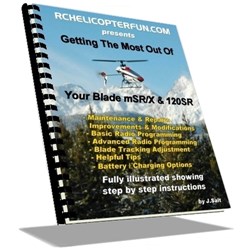Blade mSR X Review – Micro Fixed Pitch Flybarless Fun!
by John Salt
The Blade mSR X was Blade’s first micro sized fixed pitch heli that used their popular micro sized AS3X three axis flybarless stabilization/gyro system. The mSR S or Blade 70S are the latest replacement fixed pitch micro sized helicopter offerings from blade that cater to the beginner.
Micro flybarless technology was something that I predicted would be filtering down to the rest of the micro heli Blade line-up that all started with the remarkable little Blade mCPX micro collective pitch RC helicopter.
The big difference this time round is it’s now being used for the first time on a fixed pitch RC helicopter. If you have read my review on the original mSR , you know how much I liked it and thought it was one of the best transitional steps up to collective pitch from micro coaxial, the new X version is even better for this – in fact, it could be called the perfect transitional step.
I was pretty excited when I heard about this release and knew it was I heli I had to get and test. The potential for the flybarless system on the new Blade mSR X to overcome some of the annoying short comings on the original mSR flybar version was reason alone to bring this little micro home and after a week of test flying and having a little too much fun in the process, it has confirmed everything I thought and provided a few surprises as well. In short, it’s a huge improvement over the original mSR but still shares much of the same DNA.
Watch the Blade mSR X in Action!
Blade mSR X Design
Before getting into the flight performance and behavioral characteristics, let’s have a closer look at the Blade mSRX to see what’s different from the original.
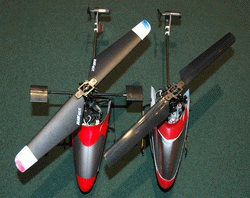 Blade mSR/X Comparison
Blade mSR/X ComparisonWhen viewing both versions of the mSR’s from the top, you can immediately see the biggest stand out being of course the lack of a flybar on the X version (the heli on the right) as well as a much cleaner and simplified Bell rotor head.
The blades too are different using a more conventional higher performance shape over the aggressive delta shape high lift blades used on the flybar version. These performance blades produce a conventional 90 degree gyroscopic precession meaning there is no strange offset swash phasing like on all the other fixed pitch flybar micro helis. This produces swashplate movement that is more intuitive to the first time RC heli flyer because it’s easy to see that a forward cyclic command is now translated directly into a forward tilt of the swash with no funny phasing off angles making servo direction settings a little easier to understand for the newbie.
The down side is without a computerized radio to bind the mSRX to, it’s impossible to really tame down the fairly aggressive cyclic response that all flybarless Bell heads are capable of delivering. The simple 4 channel stock transmitter that comes with the RTF version has a simple dual rate mode, but for most people, it's not nearly enough, at least when first learning to hover.
My ebook on the mSR, mSRX, and 120SR, goes over setting up your Blade mSR X to tame it down so it's not as aggressive for the beginner pilot. I have many other tips in this ebook as well, so if you think it might help you out with your mSRX, click on the image to learn more about what's covered.
The next item to note is the Blade mSR X has an evolved larger brain over that of the original flybar version.
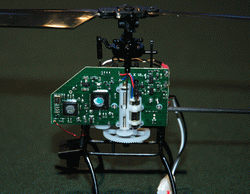 Blade mSR X 4 in 1 Circuit Board
Blade mSR X 4 in 1 Circuit BoardThe new and larger 4-in-1 board that is now mounted on the left side of the frame incorporates the patented DSM2/X receiver, ESC, two swash servos, and of course the AS3X 3 axis MEMS gyro.
In actuality, this board could be considered an 8-in-1 because it really is supporting eight individual functions: Receiver, ESC, tail motor driver/mixer, cyclic pitch servo, cyclic roll servo, cyclic pitch gyro, cyclic roll gyro, and tail gyro. I only mention this to point out all the technology that is crammed onto this little board.
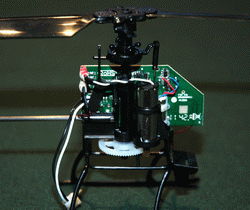 Blade mSR X Offset Main Motor
Blade mSR X Offset Main MotorTo balance the weight from side to side, the coreless main motor (which is now slightly larger and more powerful) has been mounted/offset to the right side of the frame making it super easy to access for replacement if required.
The two liner servos are an improvement over the ones used on the original mSR in both power and performance. They are actually very similar to the ones used in the Blade mCPX and boast both upper and lower shaft bearings over simple bushings found on the original and a longer travel range for improved resolution. The placement of the servos also protects the servo gearing better than on the original making it less likely for a servo gear to bind on something like an incorrectly installed battery/canopy, or from picking up a piece of dust/lint that can jam the tiny gears.
It's these little innovative steps that are largely overlooked and in my opinion, is what sets Blade apart from the rest of the entry level micro heli market segment. That pretty much covers the main design differences, from the frame back the Blade mSR X is the same as the original.
BLADE mSR X FLIGHT CHARACTERISTICS & PERFORMANCE
As I mentioned early on, I consider the Blade mSR X, to be one of the best transitional learning aids into collective pitch right now. Why? It boils down to the way the cyclic responds and feels while learning to hover.
It is poised right in-between a super stable micro coaxial and an unstable collective pitch bird. Even faster flight is duplicated to an extent, but of course the limiting factors with any fixed pitch heli start showing up; that said, the Blade mSR X is by far the best performing fixed pitch heli I have ever flown.
 Blade mSR X Flying Well For A Micro Fixed Pitch RC Helicopter
Blade mSR X Flying Well For A Micro Fixed Pitch RC HelicopterFlight speed stability is on par with a collective bird – up to a point. If you know you want to get into collective pitch, but are not sure if you are ready to take the plunge yet, or perhaps you have tried collective pitch and for whatever reason just can’t get a handle on the balancing act required, the Blade mSR X will almost certainly help with those skills.
The single largest improvement in overall flight performance over the original flybar version is no more pendulum effect that violently swings the heli back into a stable hover if the speed picks up too much or when you center your cyclic stick. Again if you read my review on the mSR or the 120SR that is one of the most annoying flight characteristics both those helis share. The flybarless version completely does away with micro flybar pendulum and feels much more like flying a collective pitch heli.
There is a downside to no more aggressive pendulum naturally and that is the pilot now has to actively control the cyclic. No more hands off hovering for any length of time in other words and no more letting go of the sticks to get the heli back into a stable hover. Just like a collective pitch heli, you have to tell the heli to stop moving by giving cyclic counter corrections to stop it and continually give small cyclic commands to keep it hovering on the air bubble. Active piloting is the rule of the day in other words.
The upside to this is a much more enjoyable flying experience that more closely replicates collective pitch performance and stability in faster flight. The AS3X system does a good job at locking onto a specific amount of forward, backward, left, or right cyclic, keeping the little Blade mSR X flying along at that same attitude. I did experience some bobbles and wobbles, but these were most likely caused by some small wind gusts. The windier it got the more the Blade mSR X got pushed around and the less stable it became. It's however a noticeable improvement in small amounts of wind over what the flybar version could handle.
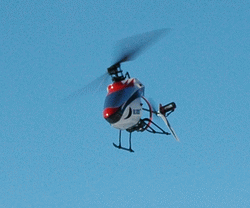 mSR X High Approach
mSR X High ApproachAs you can see, the Blade mSR X has an attractive canopy with sculpted and rounded out side cheeks that give it a slightly larger and plump flying stance over the wedge shaped cheeks on the original.
The red, white, and black graphics along with the silver window make it easy to see the correct orientation in most lighting conditions.
The other nice benefit with the flybarless version over the original is there is no dissymmetry of lift encountered when flying at faster speeds. This is a problem on the mSR and to an even greater extent the 120SR, but likely due to the higher performance rotor blade design, slightly higher head speed, and the flybarless sensors, that combined, do correct for any dissymmetry rolling tendencies on the Blade mSR X. In short, the mSRX tracks straight and true.
Lastly, TBE ( toilet bowl effect ) is a thing of the past on the mSRX and every micro flybarless Blade heli from this point forward. No flybar to react out of phase so no more TBE!!!
Tail hold was another very impressive surprise. The tail hold on the small Blade mSR X is the best of any stock motorized tail heli I have flown to date. Even instant full power climb-outs from a hover would barely impart any tail blow out – perhaps a few degrees at most but the instant the torque spike dissipated, the heading lock tail gyro would nine times out of ten get the heli pointed back on the exact heading it was in before.
The heading lock gyro was almost as capable when drastically reducing power. Due to the limitations of fixed pitch tail rotors, the Blade mSR X will rapidly blow out when a sudden loss of main rotor power is encountered, but the instant the power comes back on the gyro most of the time got the heli pointed back in the same direction and did so very quickly.
Outdoor flight in no wind is where the Blade mSR X shines due to its speed and performance potential but indoors with tamed down settings it is certainly very manageable and can be made very docile. Perhaps the original mSR was a better indoor heli for the beginner due to the self corrective pendulum qualities of the flybar, but once you master your hovering skills, the flybarless X version will definitely give you more flying fun and you’ll be building collective pitch transferable skills without even knowing it.
Flight times were about 5 minutes so that’s about the same as the
original version so getting more LiPo packs for it if you want to have a
few back to back flights is a good call (the RTF mSR X only comes with
one LiPo & the BNF mSR X comes with no LiPo).
The LiPo packs I have had the best successes with in both the mSR and now the mSR X are the
Turnigy NanoTech 1S 160 mAh 25-40C
from HobbyKing.
They consistently provide a noticeable power increase and have a longer
life span. These micro NanoTech LiPo’s are always on backorder it seems
because of how popular and inexpensive they are, so expect a wait or
stock up like I do when they are in stock.
FLYBARLESS DEFICIENCIES
Okay, maybe deficiency is not the best term to use; perhaps differences would be a better choice.
I have been swamped with emails from people who are having all sorts of issues with their Blade mSRx and think there is something wrong with it because it sometimes takes off in wild directions or the swashplate is not responding or centering the way they think it should.
In almost all cases, this is not a fault of the heli, it’s the way the flybarless stabilization system works and I’m only putting this little "flybarless stabilization primer" up here to alleviate any more questions about it.
An electronic flybarless stabilization systems works just like a heading lock tail gyro (they after all use the exact same heading lock gyro technology); so if you have read my write-up on heading lock gyros or my flybarless write-up , you'll have a better understanding of this.
There are two very important things you have to understand with these electronic stabilization systems:
- You are not in control of the cyclic servos, the AS3X gyros are! When you give a cyclic command on the radio, you are telling the gyros to allow the heli to move in a certain direction at a certain speed; they then move the swashplate servos to the required position to fulfill that command and are constantly monitoring both your instructions and what the bird is doing to keep both in sync.
- These gyros operate in a feedback loop meaning the only time they will respond correctly is when the heli is up in the air and allowed to naturally move around. While on the ground when the heli is unable to move, strange things will appear to be taking place. If you hold in full right cyclic for example, while on the ground and the heli can’t move, the gyro gives a right cyclic command but detects no movement. It keeps holding in right cyclic even after you center your stick and the swash will remain tilted right if you have a close look at it - the gyro is confused. Now as soon as you lift off, there is a large component of right cyclic being held in by the gyro and the heli immediately shoots off hard to the right the instant you get light on the skids or leave the ground – sound familiar???
The best way to approach this is the same way you deal with a heading lock tail gyro by giving small command inputs just before lift off (like I demonstrate on day 3 and 4 of my flight school videos) to make sure the gyros are more or less going to allow a level take off and are not holding in a large amount of feedback loop induced cyclic.
I like to spool up very slowly getting lighter and lighter on the skids while giving very small cyclic commands the entire time so when I do leave the ground there are no surprises with a heli that quickly drifts out. As you gain more skill, you will be able to react fast enough the instant it leaves the ground to correct for this and take off very quickly, but while you're first learning – take your time when lifting off so the AS3X system will have the swash in a level state as you lift off.
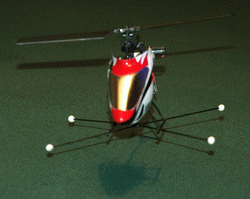 Blade mSR X Sporting A Set Of Micro Training Gear
Blade mSR X Sporting A Set Of Micro Training GearWhen you're first learning to hover your mSR X, fitting the set of inexpensive eFlite/Blade micro training gear or building your own is a must do. For only a few bucks they are worth every cent and then some!
As with all single rotor helis with tail rotors, there will be some left TRTT (tail rotor translating tendency) that you have to anticipate for and may have to hold in a little right cyclic to compensate for the tail rotor thrust just as you lift off, but other than that, the Blade mSR X will lift off in perfect cyclic trim most of the time and once in the air, the AS3X system keeps it in perfect trim throughout the entire flight (yep it will even lean the heli to the right to vector in some cyclic TRTT compensation). Not one click of cyclic or tail rotor trim have I had to give in over 30 flights – the AS3X stabilization system works so well.
While talking about flybarless feedback, I should also point out that flybarless stabilization systems, just like heading lock tail gyros, are always sending tiny signals to the servos (even while the birds are sitting stationary) and that causes the servos to "sing" a little bit. The mSRX and mCPX servos have a very high pitch singing voice, but it’s perfectly normal.
BLADE mSR X VERSIONS & SPECIFICATIONS
As with all Blade helis, the mSRX comes in two versions:
- Ready to Fly (Part # BLH-3200)
- Bind & Fly (Part # BLH-3250)
The ready to fly version comes with the mSR X RC helicopter, the basic MLP4DSM 2.4GHz DSM2 4-Channel radio, a single 1S 3.7V 150mAh 25C Li-Po Battery, and the very basic single cell micro LiPo charger. There is also a small Phillips screw driver, a couple spare pushrods, a spare tail rotor blade, instructions, and an instructional repair DVD.
The BNF version comes with all the same stuff, less radio, battery, and battery charger. I was impressed that the BNF versions are now being packaged in nice small boxes over the same large box that the RTF version comes in. This saved on shipping costs and is just a good all round idea in my opinion.
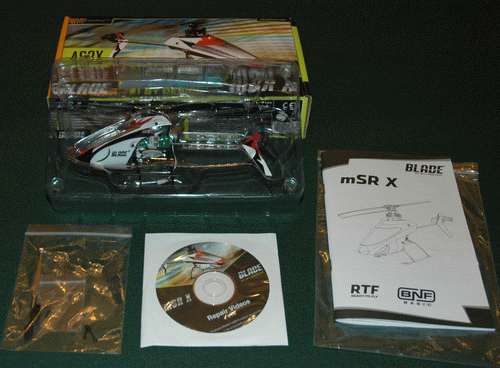 Blade mSR X BNF Kit Unboxing
Blade mSR X BNF Kit UnboxingThe BNF Blade mSR X version is what I purchased so I could bind it directly to my JR X9503 radio. I’m a strong believer that this little heli needs to be bound to a computerized radio if you do want to tame it down to make it more beginner friendly, so take that into consideration when choosing between either version.
Blade mSR X Specifications
- Type: Electric micro single rotor fixed pitch RC helicopter with electronic flybarless stabilization (AS3X System)
- Main Rotor Diameter: 7.13 in (181mm)
- Main Motor Type: Coreless
- Tail Rotor Diameter: 1.46 in (37mm)
- Tail Rotor Type: Coreless
- Length: 7.44 in (189mm)
- Gross Weight: 1.09 oz (31 g)
- Flight Battery: 1S(3.7V) 150mAh 25C LiPo
- Flying Environment: Indoor/Outdoor (calm conditions)
- No assembly required

